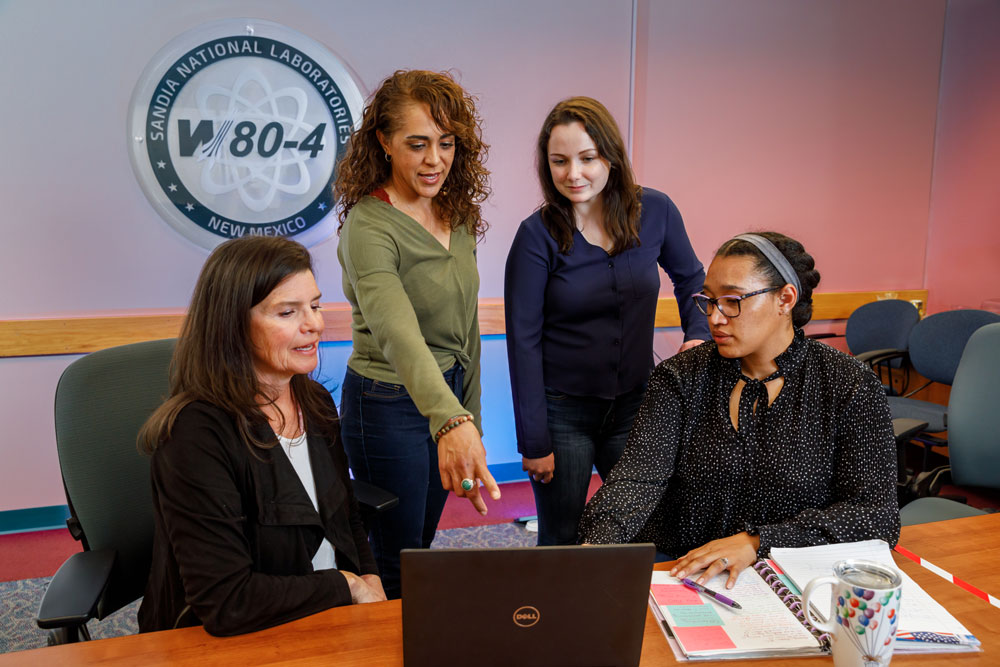Nuclear deterrence programs see rapid expansion, take steps to bolster national defense

Sandia’s nuclear deterrence programs are responsible for stewardship and modernization of the U.S. nuclear weapons stockpile, from foundational and exploratory science and technology through annual assessment and modernization activities to final disposition.
“Nuclear deterrence continues to be the core mission for Sandia and the Integrated Security Solutions division,” said Associate Labs Director Andy McIlroy. “We are growing quickly, significantly increasing both hiring and facility development to ensure we have people and resources to keep pace with the rising demands of our complex and challenging nuclear deterrence modernization and stockpile programs.”
The program updates and recently completed milestones below offer a glimpse into the critical efforts being undertaken by the division’s nuclear deterrence community.
Nuclear Weapons Council extends the W80-4 program by 24 months
The Nuclear Weapons Council on June 29 approved a 24-month extension to the deadline for the W80-4 Life Extension Program, moving the target for the first production unit to September 2027. Following the decision, Sandia began realigning program schedules to meet the more realistic date while continuing to focus on system integration and flight testing and working toward System Baseline Design Review this fall.
Sandia’s California systems engineering team led the W80-4’s initial design phases in partnership with Lawrence Livermore National Laboratory, the lead nuclear design agency, and NNSA production plants. They developed warhead design options and technologies to make the W80-4 one of the safest and most secure systems in the stockpile. Through these partnerships, Sandia is working to reduce its dependency on expensive and long-lead hardware, increase the use of digital engineering and deploy additively manufactured products.
“With the rapid expansion of our ND programs, it has never been more important to leverage our experience and institutional knowledge across all programs, both internally and with our colleagues throughout the nuclear security enterprise, to achieve our common goals,” Andy said, citing tri-site executive reviews for the W80-4 LEP that are strengthening relationships, improving communications and developing innovative solutions for shared challenges.
W87-1 program moves to Phase 6.3
NNSA’s W87-1 modernization program is heading into Phase 6.3 of the U.S. nuclear warhead lifecycle — an important engineering development phase that includes flight testing. The program recently completed Phases 6.2 and 6.2A, defining the system architecture and then costing the program’s development and execution.
To move into Phase 6.3, the program completed and submitted its Weapon Design and Cost Report to the W87-1 NNSA Federal Program Office in May. Teams across California and New Mexico developed resource-loaded schedules for the program’s projected lifespan, informing the final cost estimate. The teams held countless meetings and devoted hundreds of hours to ensuring that the artifacts and final report were of the highest quality and met rigorous requirements.
The W87-1 will provide enhanced safety and security compared to the legacy W78 warhead it will replace in the U.S. nuclear stockpile. Sandia is responsible for engineering the program’s nonnuclear components and executing system integration and qualification, in partnership with other organizations across the nuclear weapons complex.
Mk21 Fuze Replacement Program completes final qualification testing
The Mk21 Fuze Replacement Program is developing a modernized fuze to be used on intercontinental ballistic missiles as part of the land leg of the nation’s nuclear deterrent. Working on behalf of the Air Force and targeting a May 2024 first production unit, Sandia is completing its final round of qualification testing that includes flight testing, electrical system reviews, vibration and shock testing and qualification.
The Mk21 Fuze leverages components and expertise at the Labs, especially the W88 Alteration 370 Fuze designed for the U.S. Navy.
W87-0 successfully executes firedown test
With a goal of developing the first warhead to be fielded on the Air Force’s new Sentinel ground-based strategic deterrent missile, the W87-0 team is creating a joint environmental test unit to provide Sandia, Lawrence Livermore National Laboratory and the Air Force with environmental data from test flights to certify the weapon system for operational use. The team is also developing an updated joint test assembly to provide encrypted telemetry for instrumented flights.
Sandia’s W87-0 program successfully executed a firedown test in July on the updated joint test assembly and ground test unit. The team collected data, and the telemetry ground station recorded the simulated flight test. Initial results indicate that the system tester provided the proper signals to the fuze and weapon components to charge and fire.
The ground test unit performed as expected and was a success. The test provided mission confidence data for the upcoming Mk21 Fuze flight telemetry system and reduced qualification risks on the instrumented joint test assembly for the Sentinel missile by gathering evidence of a capable design just prior to the program’s baseline design review.
Annual stockpile assessment moves forward
The California stockpile systems teams are instrumental in preparing Sandia’s portion of the annual stockpile assessment — a review of the safety, reliability and performance of the nation’s nuclear stockpile. In preparation for the Labs Director’s annual nuclear weapons stockpile assessment letter, teams have completed the Cycle 27 annual assessment report, the technical basis annual review and component assessment reports. Sandia’s results are compiled with those from other nuclear weapons laboratories and included in the final report, which is delivered to the president and secretaries of energy and defense.
“The United States relies on its nuclear weapons stockpile to deter aggression from adversaries,” said Dan Fonte, director of Stockpile Systems and Component Engineering. “To serve effectively, our weapons must be highly reliable and function when called on to do so, but must remain safe from unintended detonation at all other times. The annual assessment is significant, and it is to this end that we work with the highest diligence and integrity.”